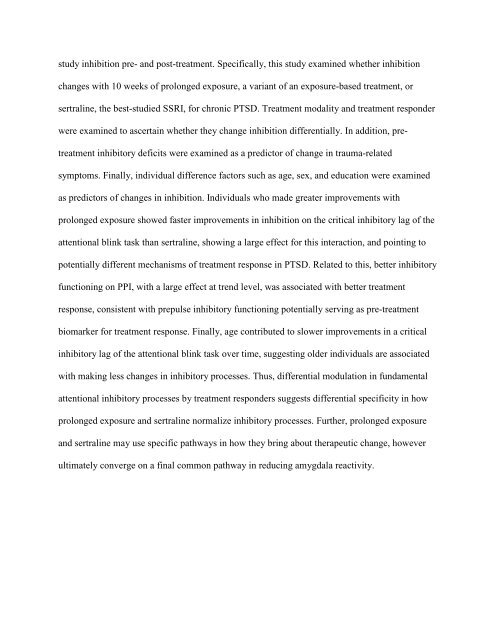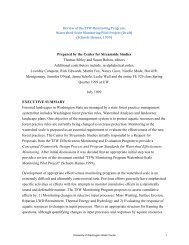Copyright 2012 Aileen M. Echiverri-Cohen - University of Washington
Copyright 2012 Aileen M. Echiverri-Cohen - University of Washington
Copyright 2012 Aileen M. Echiverri-Cohen - University of Washington
You also want an ePaper? Increase the reach of your titles
YUMPU automatically turns print PDFs into web optimized ePapers that Google loves.
study inhibition pre- and post-treatment. Specifically, this study examined whether inhibition<br />
changes with 10 weeks <strong>of</strong> prolonged exposure, a variant <strong>of</strong> an exposure-based treatment, or<br />
sertraline, the best-studied SSRI, for chronic PTSD. Treatment modality and treatment responder<br />
were examined to ascertain whether they change inhibition differentially. In addition, pre-<br />
treatment inhibitory deficits were examined as a predictor <strong>of</strong> change in trauma-related<br />
symptoms. Finally, individual difference factors such as age, sex, and education were examined<br />
as predictors <strong>of</strong> changes in inhibition. Individuals who made greater improvements with<br />
prolonged exposure showed faster improvements in inhibition on the critical inhibitory lag <strong>of</strong> the<br />
attentional blink task than sertraline, showing a large effect for this interaction, and pointing to<br />
potentially different mechanisms <strong>of</strong> treatment response in PTSD. Related to this, better inhibitory<br />
functioning on PPI, with a large effect at trend level, was associated with better treatment<br />
response, consistent with prepulse inhibitory functioning potentially serving as pre-treatment<br />
biomarker for treatment response. Finally, age contributed to slower improvements in a critical<br />
inhibitory lag <strong>of</strong> the attentional blink task over time, suggesting older individuals are associated<br />
with making less changes in inhibitory processes. Thus, differential modulation in fundamental<br />
attentional inhibitory processes by treatment responders suggests differential specificity in how<br />
prolonged exposure and sertraline normalize inhibitory processes. Further, prolonged exposure<br />
and sertraline may use specific pathways in how they bring about therapeutic change, however<br />
ultimately converge on a final common pathway in reducing amygdala reactivity.
















